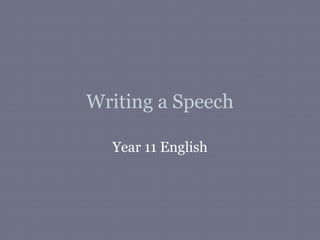
Writinga speech
- 1. Writing a Speech Year 11 English
- 2. Speech •Remember your speech is designed to be spoken not read, this will effect your language choices. •A speech is NOT an essay read aloud, it must be designed to be presented and thus be engaging (recognise that you have an audience) •Introduction – address your audience, welcome them to the event you are speaking at – introduce yourself, your topic and your contention in the opening address – You must refer to your audience in your opening and throughout your response – E.g. “Ladies and Gentlemen, welcome to… (introduce your event)”. Or “Delegates, welcome to this years …conference on …”I’m sure all the voters here tonight agree”
- 3. Speech •Use cue cards with key points to help you remember your speech, do NOT read from a pre prepared speech. •Practice in front of an audience & in timed conditions to reduce nerves and increase fluency •Choose appropriate language. Either formal or informal depended on your persona, audience and event. •Your introduction may start with a ‘hook’, this may include an anecdote (story), a reference to well known event in the media or from History or by posing a question which you will go on to answer. •Ask yourself: Why should your audience care about this issue? How is it relevant to their lives?
- 4. Speech • You MUST have a PERSONA (someone who cares about this topic, you cannot present as yourself) • Decide what TONE your piece will have, humorous, outraged, attacking, reasoned? Your tone needs to be appropriate to your persona and will help determine what persuasive techniques you use. • The body of your argument should generally follow essay structure (use TEEL) you should have at least three supporting arguments which each form three body paragraphs
- 5. Speech • Consciously use signposting (firstly, secondly), connectives (moreover, furthermore, however, in contrast) and persuasive devices (e.g. attacks, inclusive language, humour appeals to authority, appeals to fear, statistics, rhetorical questions) • Also include a rebuttal of opposing arguments. – A rebuttal is where you recognise what your opponents might say and then explain why they are wrong. – E.g. “While some commentators may claim that … this way of thinking is illogical because…” • A powerful conclusion should reiterate your contention and leave your audience with a clear message a direction of what you want them to believe or do and why.
- 6. Standard Structure Hook Formal Introduction 1st Argument (Use TEEL Structure for this paragraph) 2nd Argument (Use TEEL Structure for this paragraph) 3rd Argument (Use TEEL Structure for this paragraph) Rebuttal of possible opponents Conclusion • Note: This is the standard structure of a persuasive speech and you may deviate from it. For example, you may include your rebuttal after your second and third paragraphs. However, this structure should be used as a guide.
- 7. The Writing Process 1. Complete your speech plan & get it approved 2. Complete your research so that you know your topic, arguments and possible rebuttal very well 3. Write up a draft of your speech in a Word Document 4. Include body language and delivery notes to emphasise certain words, pause, speak loudly etc. 5. Practice delivering your speech and seek feedback 6. Convert your speech into dot point cue cards 7. Practice delivering your speech and seek feedback
- 8. Criteria Criterion 1 (12 marks) Knowledge and use of the chosen content: •Effective and appropriate exploration of the complexities of the chosen content •Accurate and detailed acknowledgement of sources used Criterion 2 (6 marks) Coherence and development of ideas and effective structure of the whole presentation: •Structure appropriate to the form •Effective election of & appropriate structuring of ideas •Coherent ordering and development of ideas •Clear signposting of arguments •Persona and audience appropriate to topic Criterion 3 (6 marks) Control of the features of spoken English: •Control of appropriate oral language conventions •Effective and accurate vocabulary appropriate to purpose, persona & audience •Expressiveness and fluency Criterion 4 (6 marks) Effective interaction with audience and controlled use of non-verbal aspects of language •Obvious engagement with audience •Appropriate development of persona •Engaging opening and strong finish •Ability to use non-verbal aspects of language such as tone/pitch/gestures etc. appropriately and effectively
- 9. Rules Timing •2 minutes, 30 seconds – knock on desk •3 minutes – timekeeper says “time” •3 minutes, 30 minutes – presenter is stopped If a student refuses or is not prepared to present when called… – Talk to student after class, explaining to them the consequences of refusing to present – Notify BEN of 1st refusal – Students receive a second chance to present but lose a whole grade (i.e. C+ = D+) – If the student presents during the next lesson (i.e. at the second opportunity), their maximum grade can only be a B
- 10. Presentation Procedure • All students should be ready to begin presenting from the second English lesson in the first week of term – immediately after the holidays! • Call for volunteers – allow the volunteers to go first (however, they do not receive any extra grades for volunteering). • Once all volunteers have presented (or if no one volunteers), begin to pull names out of a hat (or other random selection process). Names should only be pulled out for that lesson – students should be ready for each English lesson that they attend in case that is the day. • Record time taken on the assessment sheet.